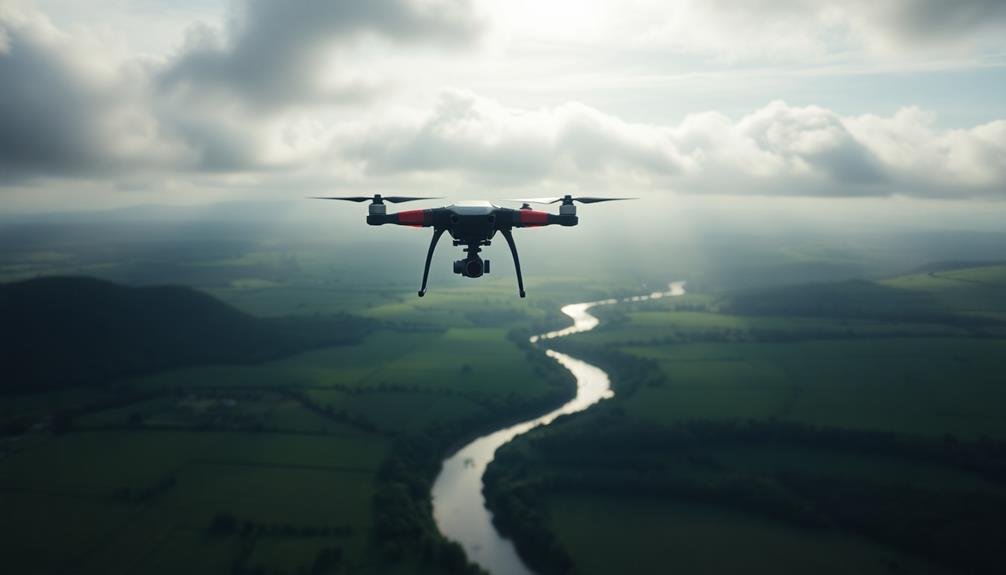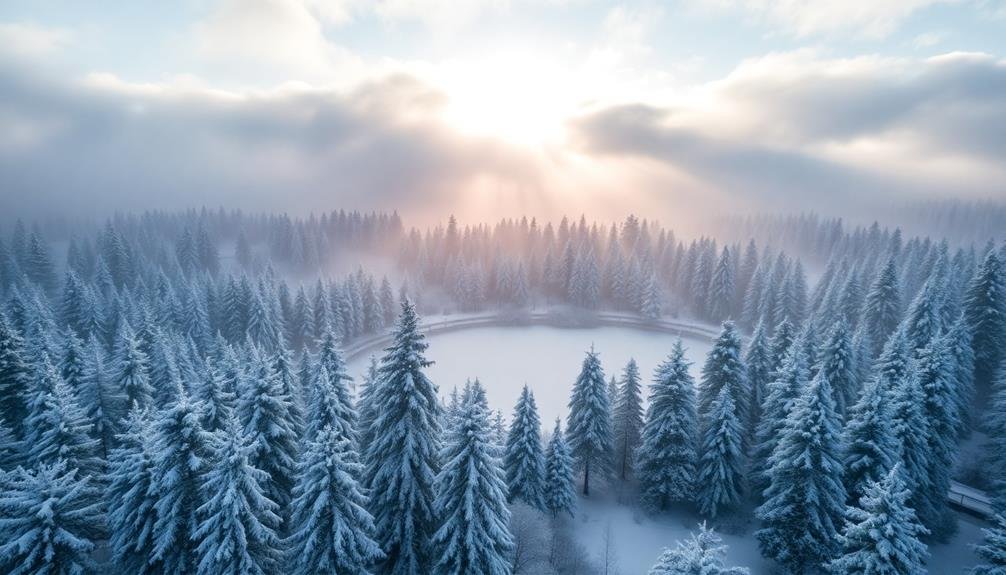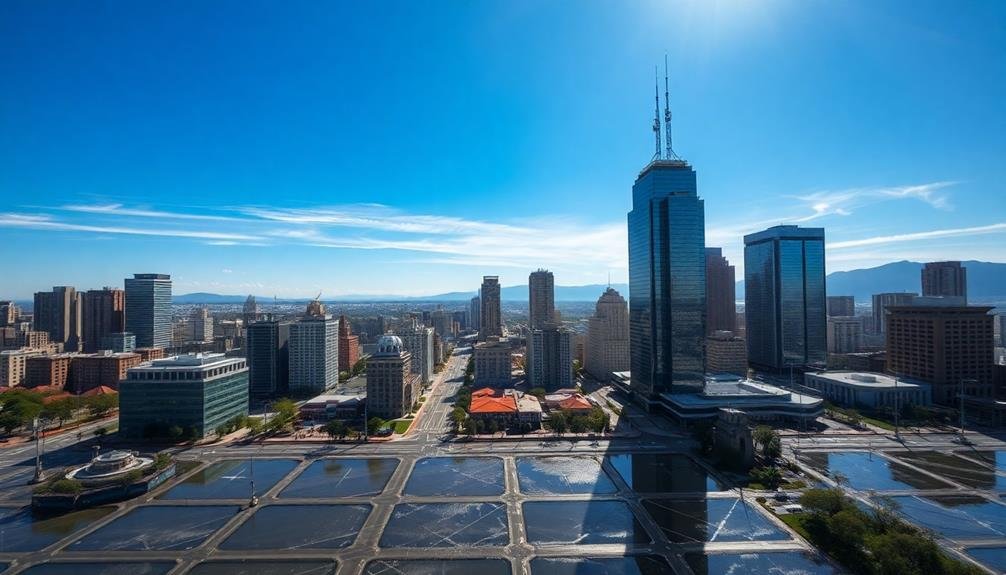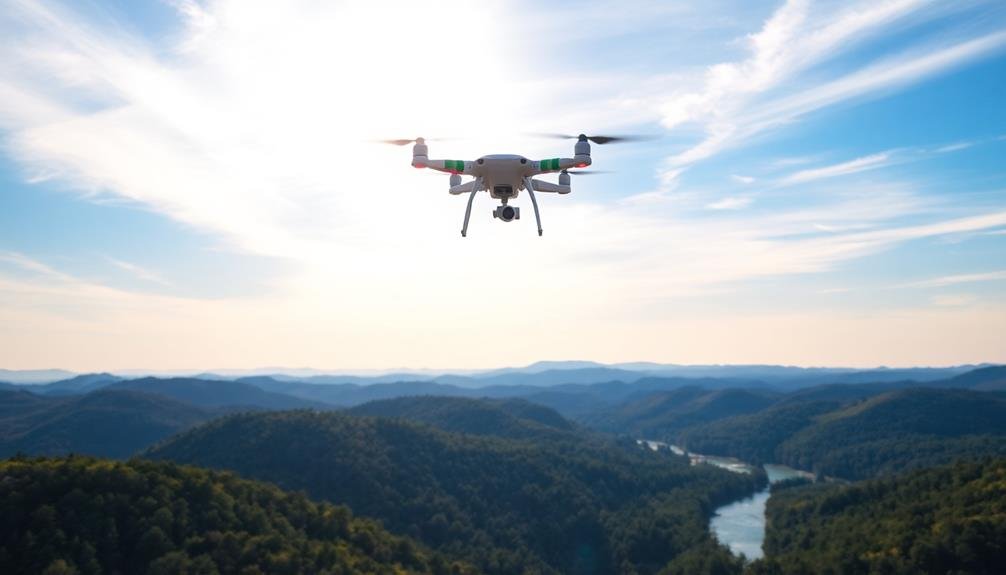For aerial photography success, you'll want to capitalize on five ideal weather conditions. Clear skies with gentle breezes offer perfect visibility and stability. Golden hour lighting, just after sunrise or before sunset, creates magical, soft illumination. Overcast days provide diffused light and soft shadows, enhancing colors and textures. Light snowfall transforms landscapes into winter wonderlands, perfect for unique shots. Post-rain conditions bring clarity, reflections, and vibrant colors to your aerial images. By understanding these prime conditions, you'll be well-equipped to capture stunning aerial photographs. Explore each scenario to reveal the full potential of your drone photography skills.
Key Takeaways
- Clear skies with gentle breezes offer optimal visibility and stability for aerial photography.
- Golden hour lighting shortly after sunrise or before sunset enhances colors and textures in aerial shots.
- Overcast days provide soft, diffused light, eliminating harsh shadows and allowing flexible shooting directions.
- Light snowfall creates magical winter scenes, requiring adjusted camera settings for optimal results.
- Post-rain conditions offer improved clarity, stunning reflections, and vibrant colors for aerial photography.
Clear Skies and Gentle Breezes

On a perfect day for aerial photography, clear skies and gentle breezes create ideal conditions.
You'll find that these elements combine to offer unparalleled visibility and stability for your aerial shots. Clear skies provide consistent, natural lighting that illuminates your subject evenly, eliminating harsh shadows and allowing for crisp, vibrant images.
Gentle breezes, typically under 10 mph, offer just enough air movement to keep your drone stable without causing unwanted motion blur.
You'll be able to capture smooth, steady footage and sharp still images with ease. These light winds also help prevent heat haze, which can distort your shots on excessively calm days.
When planning your aerial shoot, aim for early morning or late afternoon hours.
The golden hour light during these times adds warmth and depth to your photos, enhancing landscapes and architectural features. You'll also benefit from reduced atmospheric turbulence during these periods, further improving image quality.
Remember to check weather forecasts and plan accordingly.
Clear days with gentle breezes are often associated with high-pressure systems, so keep an eye out for these prime conditions to maximize your aerial photography success.
Golden Hour Lighting

Bathing your aerial shots in warm, golden light, the "golden hour" offers photographers a magical window of opportunity. This coveted period occurs twice daily, shortly after sunrise and before sunset, when the sun's low position creates a soft, diffused light that enhances colors and textures.
During the golden hour, you'll notice longer shadows that add depth and dimension to your aerial photographs. The warm hues cast by the sun can transform ordinary landscapes into extraordinary scenes, making even mundane subjects appear enchanting.
To capture the best golden hour shots, you'll need to plan ahead and be ready to act quickly, as this fleeting moment typically lasts only 20-30 minutes.
When shooting during the golden hour, you'll want to adjust your camera settings to make the most of the unique lighting conditions. Consider using a lower ISO to reduce noise and a wider aperture to capture more light.
You may also need to experiment with your white balance settings to accurately capture the warm tones. Remember to position your drone to take advantage of the sun's direction, using backlighting or side-lighting techniques to create stunning visual effects in your aerial photography.
Overcast Days for Soft Shadows

While many photographers crave sunny skies, overcast days can be a hidden gem for aerial photography. Cloudy conditions create soft, diffused light that eliminates harsh shadows and reduces contrast. This even lighting allows you to capture details in both highlight and shadow areas, resulting in more balanced images.
When shooting on overcast days, you'll find that colors appear more saturated and true to life. The lack of direct sunlight prevents glare and reflections, especially when photographing water bodies or reflective surfaces. You'll also have more flexibility regarding shooting direction, as you won't need to worry about the sun's position.
Here's a quick comparison of overcast vs. sunny conditions for aerial photography:
| Aspect | Overcast | Sunny |
|---|---|---|
| Shadows | Soft, minimal | Hard, pronounced |
| Contrast | Low | High |
| Color saturation | Enhanced | Can appear washed out |
| Shooting direction | Flexible | Limited by sun position |
To make the most of overcast conditions, use a polarizing filter to reduce any remaining glare and boost color saturation. Experiment with longer exposures to capture movement in clouds or water. Remember to adjust your camera settings, as you may need to increase ISO or widen your aperture to compensate for the reduced light.
Light Snowfall for Winter Scenes

Snowflakes drifting gently from the sky can transform aerial photography into a magical winter wonderland. Light snowfall provides a unique opportunity to capture stunning aerial images that evoke a sense of tranquility and beauty. When you're planning a winter aerial shoot, look for days with light, steady snowfall to achieve the best results.
To make the most of these conditions, consider the following tips:
- Use a slower shutter speed to capture the falling snow's motion.
- Increase your ISO to compensate for the reduced light.
- Opt for a wider aperture to create a shallow depth of field.
- Adjust your white balance to capture the snow's true color.
As you fly, keep an eye out for contrasting elements like dark trees or colorful buildings that stand out against the white landscape.
The soft, diffused light created by snowfall can help minimize harsh shadows and create a more even exposure across your images. Remember to protect your equipment from moisture and cold temperatures, and always prioritize safety when flying in winter conditions.
With the right preparation and technique, you'll be able to capture breathtaking aerial winter scenes that showcase the unique beauty of light snowfall.
Post-Rain Clarity and Reflections

After a rainstorm, the atmosphere often clears, creating ideal conditions for aerial photography. You'll notice the air becomes crisp and clean, with improved visibility that allows for sharper, more detailed images. The rain washes away dust and pollutants, resulting in a clearer sky and enhanced contrast in your shots.
Take advantage of the wet surfaces left behind by the rain. They'll create stunning reflections, adding depth and interest to your aerial photographs. Puddles, lakes, and rivers will mirror the sky and surrounding landscape, offering unique compositional opportunities. You'll find that these reflections can transform ordinary scenes into extraordinary ones.
Don't forget to look for rainbows, which often appear after a storm. They can add a magical element to your aerial shots, especially when captured from above.
You might also notice that colors appear more vibrant and saturated in post-rain conditions, enhancing the overall visual appeal of your images.
Timing is essential, so be ready to fly as soon as the rain stops. The best conditions are often short-lived, so you'll need to act quickly to capture the perfect post-rain aerial shots.
Frequently Asked Questions
How Does Humidity Affect Aerial Photography Equipment?
You'll find that high humidity can fog up your camera lens and cause condensation on your equipment. It may also affect image quality and increase the risk of corrosion. Always protect your gear and consider using anti-fog solutions.
What Safety Precautions Should Be Taken During Extreme Weather Conditions?
You'll need to prioritize safety during extreme weather. Don't fly in high winds, heavy rain, or thunderstorms. Check forecasts, use protective gear, and have a clear emergency plan. Always be ready to abort the mission if conditions worsen.
Can Aerial Photography Be Conducted at Night?
Yes, you can conduct aerial photography at night. You'll need specialized equipment like low-light cameras or thermal imaging devices. It's challenging, but you'll capture unique shots. Remember to follow local regulations and prioritize safety when flying at night.
How Do Different Altitudes Impact Weather Conditions for Aerial Photography?
As you ascend, you'll encounter varying weather conditions. Higher altitudes often mean colder temperatures, thinner air, and stronger winds. Lower altitudes typically offer more stable conditions, but you'll need to watch for localized weather patterns.
What Insurance Considerations Are Necessary for Weather-Related Risks in Aerial Photography?
You'll need extensive insurance that covers weather-related risks for your aerial photography. It should include protection for equipment damage, liability, and cancelled shoots due to adverse conditions. Don't forget to review altitude-specific clauses.
In Summary
You've now got the inside scoop on perfect weather for aerial photography. Remember, it's not just about clear skies – each condition offers unique opportunities. Whether you're chasing golden hour light or braving a light snowfall, you'll capture stunning shots. Don't let less-than-ideal weather stop you; there's always a chance for great photos. Keep these tips in mind, and you'll be well-equipped to make the most of any aerial shoot.

As educators and advocates for responsible drone use, we’re committed to sharing our knowledge and expertise with aspiring aerial photographers.




Leave a Reply